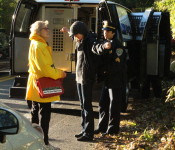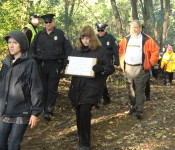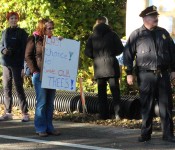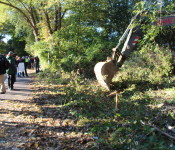Don’t expect big changes to the outside of the former Macy’s/Filene’s Belmont Center location over the next year; the excitement will be left for what will go inside, according to the landlord of the property who revealed just a bit of the site’s future Thursday night.
Locatelli Properties’s Kevin Foley and his colleague, Len Simons, held a public meeting on Oct. 30, at Belmont Town Hall to preview their presentation to the Belmont Zoning Board of Appeals as they seek three special permits to allow “minor” alterations to the building.
If everything goes to plan, retailers and restaurants at new site – without a name for now – will open for business by the spring of 2016.
The presentation before the ZBA will be held on Monday, Nov. 3 at 7 p.m. in the Belmont Gallery of Art, on the third floor of the Homer Building in the Belmont Town Hall complex.
After the renovation work is completed, the site – located at the corner of Alexander and Leonard streets – will have approximately 48,000 sq.-ft. of commercial space available to lease, said Foley.
Since the late 60s, the building has “not been touched so it needs to be updated to bring back ‘zip’ to the Center,” Simons said of the commercial space leased to Filene’s from May 1941 to September 2006 when Macy’s bought Filene’s. Macy’s closed in January 2013.
Belmont-based Locatelli will seek ZBA permission on Monday, Nov. 3, to build a new vestibule off the parking-lot side of the building where the stairs to the women’s department was located, the installation of accessibility ramps and an elevator at the rear of the building, a renovated entryway and a new roof system on the Leonard Street side. In addition, windows will be installed and new entry ways created along Leonard Street.

“We need to include an elevator as we are required to make all floors accessible to the law,” said Simons.
In addition to accessibility features, a new office space of about 600 sq.-ft will be constructed on the top floor.
Simons said the renovations will have no effect on the number of parking spaces in the Locatelli parking lot or in vehicle traffic patterns.
“We believe the improvements for access purposes will support our efforts to bring a mix of quality retailers to the Leonard Street area,” said a written press release handed out at the meeting.
“Once Locatelli has obtained the necessary permits, we will be able to pursue potential tenants and regenerate retail activity in Belmont Center,” said the statement.
“We anticipate two large tenants and four to five smaller ones, like those down [Leonard] street,” said Foley, who doesn’t expect one retailer to take both floors “because that’s a challenge for a retailer.”
The tenants will work with Locatelli on dividing up the interior to best utilize the space.
While Foley appeared hesitant to add another bank branch in the Center, he said just about any business would be considered.
“As long as they are high quality,” said Foley, including national retailers, existing businesses and restaurants.
“I think a mix of restaurants and retail would be the best for [foot] traffic in the day and the evening,” said Foley.














